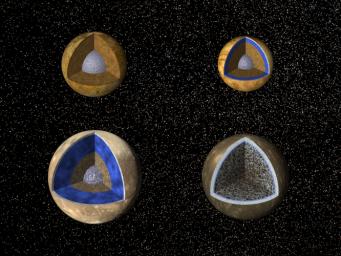
|
Possible Internal Structures of the Galilean Satellites
- Click the image above for a larger view
- Full-Res JPEG (2133 x 1600) (474.8 kB)
- Full-Res TIFF (2133 x 1600) (4.5 MB)
Caption:
Cutaway views of the possible internal structures of the Galilean satellites. Ganymede is at the lower left, Callisto at the lower right, Io on the upper left, and Europa on the upper right. The surfaces of the satellites are mosaics of images obtained in 1979 by NASA's Voyager spacecraft, and the interior characteristics are inferred from gravity field and magnetic field measurements by NASA's Galileo spacecraft. The satellites are shown according to their actual relative sizes. Ganymede's radius is 2634 kilometers (km); Callisto's is slightly smaller at 2403 km; Io's radius is 1821 km, similar to the 1738 km radius of our Moon; Europa's radius is 1565 km, not too much smaller than our Moon's radius. With the exception of Callisto, all the satellites have metallic (iron, nickel) cores (shown in gray) drawn to the correct relative size. Again, with the exception of Callisto, all the cores are surrounded by rock (shown in brown) shells. Io's rock or silicate shell extends to the surface, while the rock layers of Ganymede and Europa (drawn to correct relative scale) are in turn surrounded by shells of water in ice or liquid form (shown in blue and white and drawn to the correct relative scale). Callisto is shown as a relatively uniform mixture of comparable amounts of ice and rock. Recent data, however, suggests a more complex core as shown here (bottom right). The surface layers of Ganymede and Callisto are shown as white to indicate that they may differ from the underlying ice/rock layers in a variety of ways including, for example, the percentage of rock they contain. The white surface layer on Europa could have similar significance, although it could also suggest an ice layer overlying a liquid water ocean. Galileo images of Europa suggest that a liquid water ocean might now underlie a surface ice layer several to ten kilometers thick; however, this evidence is also consistent with the existence of a liquid water ocean in the past. It is not certain if there is a liquid water ocean on Europa at present.
Background Info:
The Jet Propulsion Laboratory, Pasadena, CA manages the Galileo mission for NASA's Office of Space Science, Washington, DC. JPL is an operating division of California Institute of Technology (Caltech).
This image and other images and data received from Galileo are posted on the World Wide Web, on the Galileo mission home page at URL http://www.jpl.nasa.gov/ galileo.
Cataloging Keywords:
| Name | Value | Additional Values |
|---|---|---|
| Target | Ganymede | Callisto, Europa, Io |
| System | Jupiter | |
| Target Type | Satellite | |
| Mission | Galileo | Voyager |
| Instrument Host | Galileo Orbiter | |
| Host Type | Orbiter | Flyby Spacecraft |
| Instrument | Solid-State Imaging (SSI) | |
| Detector | ||
| Extra Keywords | Color, Magnetosphere, Moon, Water | |
| Acquisition Date | ||
| Release Date | 2000-08-03 | |
| Date in Caption | ||
| Image Credit | NASA/JPL | |
| Source | photojournal.jpl.nasa.gov/catalog/PIA01082 | |
| Identifier | PIA01082 | |
